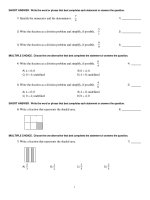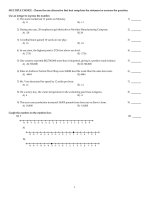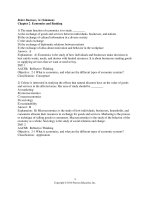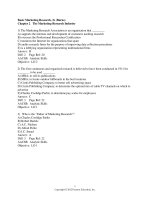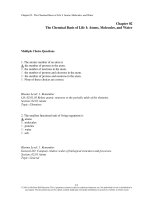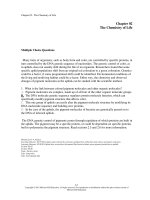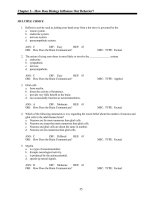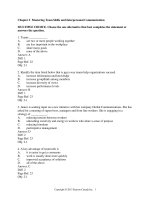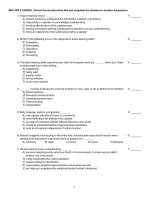Macroeconomics 3rd edition hubbard test bank
Bạn đang xem bản rút gọn của tài liệu. Xem và tải ngay bản đầy đủ của tài liệu tại đây (615.72 KB, 64 trang )
Macroeconomics, 3e (Hubbard/O'Brien) - TB2
Chapter 2 Trade-offs, Comparative Advantage, and the Market System
2.1 Production Possibilities Frontiers and Opportunity Costs
1) ________ exists because unlimited wants exceed the limited resources available to fulfill
those wants.
A) Scarcity
B) Productive efficiency
C) The command economy
D) Economic growth
Answer: A
Comment: Recurring
Diff: 2 Page Ref: 38/38
Topic: Scarcity
Objective: LO1: Use a production possibilities frontier to analyze opportunity costs and tradeoffs
AACSB: Reflective Thinking
Special Feature: None
2) To compete in the automobile market, BMW must make many strategic decisions such as
whether to introduce a new car model, whether to produce alternative-fuel vehicles, and where to
advertise. At BMW's Spartanburg, South Carolina plant, managers must decide on the monthly
production quantities of their Z4 and X5 models. In making this decision, the managers
A) face no trade-off because the Spartanburg plant only produces these two models of the many
BMW models produced worldwide.
B) face a trade-off, because producing more of one model means producing less of the other.
C) will choose to only produce the quantity of Z4 and X5 models where marginal cost equals
zero.
D) will always decide on production quantities in which revenues are maximized.
Answer: B
Diff: 2 Page Ref: 37/37
Topic: Opportunity Cost
Objective: LO1: Use a production possibilities frontier to analyze opportunity costs and tradeoffs
AACSB: Reflective Thinking
Special Feature: Chapter Opener: Managers Making Choices at BMW
1
Copyright © 2010 Pearson Education, Inc.
3) The principle of ________ is that the economic cost of using a factor of production is the
alternative use of that factor that is given up.
A) marginal cost
B) opportunity cost
C) normative economics
D) entrepreneurship
Answer: B
Comment: Recurring
Diff: 2 Page Ref: 38/38
Topic: Opportunity Cost
Objective: LO1: Use a production possibilities frontier to analyze opportunity costs and tradeoffs
AACSB: Reflective Thinking
Special Feature: None
4) The production possibilities frontier shows
A) the various products that can be produced now and in the future.
B) the maximum attainable combinations of two products that may be produced in a particular
time period with available resources.
C) what an equitable distribution of products among citizens would be.
D) what people want firms to produce in a particular time period.
Answer: B
Comment: Recurring
Diff: 2 Page Ref: 38/38
Topic: Production Possibilities Frontiers
Objective: LO1: Use a production possibilities frontier to analyze opportunity costs and tradeoffs
AACSB: Reflective Thinking
Special Feature: None
5) ________ shows that if all resources are fully and efficiently utilized, more of one good can
be produced only by producing less of another good.
A) Comparative advantage
B) Absolute advantage.
C) The mixed market system
D) The production possibilities frontier model
Answer: D
Comment: Recurring
Diff: 2 Page Ref: 38/38
Topic: Production Possibilities Frontiers
Objective: LO1: Use a production possibilities frontier to analyze opportunity costs and tradeoffs
AACSB: Reflective Thinking
Special Feature: None
2
Copyright © 2010 Pearson Education, Inc.
6) The production possibilities frontier model assumes all of the following except
A) labor, capital, land and natural resources are fixed in quantity.
B) the economy produces only two products.
C) any level of the two products that the economy produces is currently possible.
D) the level of technology is fixed and unchanging.
Answer: C
Comment: Recurring
Diff: 2 Page Ref: 38/38
Topic: Production Possibilities Frontiers
Objective: LO1: Use a production possibilities frontier to analyze opportunity costs and tradeoffs
AACSB: Reflective Thinking
Special Feature: None
7) The ________ production points on a production possibility curve are the points along and
inside the production possibility frontier.
A) attainable
B) unattainable
C) productively efficient
D) allocatively efficient
Answer: A
Comment: Recurring
Diff: 1 Page Ref: 38/38
Topic: Production Possibilities Frontiers
Objective: LO1: Use a production possibilities frontier to analyze opportunity costs and tradeoffs
AACSB: Reflective Thinking
Special Feature: None
8) The unattainable points in a production possibilities diagram are
A) the points within the production possibilities frontier.
B) the points along the production possibilities frontier.
C) the points of the horizontal and vertical intercepts.
D) the points outside the production possibilities frontier.
Answer: D
Comment: Recurring
Diff: 1 Page Ref: 38/38
Topic: Production Possibilities Frontiers
Objective: LO1: Use a production possibilities frontier to analyze opportunity costs and tradeoffs
AACSB: Reflective Thinking
Special Feature: None
3
Copyright © 2010 Pearson Education, Inc.
Figure 2-1
9) Refer to Figure 2-1. ________ is (are) inefficient in that not all resources are being used.
A) Point A
B) Point B
C) Point C
D) Points A and C
Answer: A
Comment: Recurring
Diff: 1 Page Ref: 38/38
Topic: Production Possibilities Frontiers
Skill: Graphing
Objective: LO1: Use a production possibilities frontier to analyze opportunity costs and tradeoffs
AACSB: Reflective Thinking
Special Feature: None
10) Refer to Figure 2-1. ________ is (are) technically efficient.
A) Point A
B) Point B
C) Point C
D) Points B and C
Answer: B
Comment: Recurring
Diff: 1 Page Ref: 38/38
Topic: Production Possibilities Frontiers
Skill: Graphing
Objective: LO1: Use a production possibilities frontier to analyze opportunity costs and tradeoffs
AACSB: Reflective Thinking
Special Feature: None
4
Copyright © 2010 Pearson Education, Inc.
11) Refer to Figure 2-1. ________ is (are) unattainable with current resources.
A) Point A
B) Point B
C) Point C
D) Points A and C
Answer: C
Comment: Recurring
Diff: 1 Page Ref: 38/38
Topic: Production Possibilities Frontiers
Skill: Graphing
Objective: LO1: Use a production possibilities frontier to analyze opportunity costs and tradeoffs
AACSB: Reflective Thinking
Special Feature: None
12) In a production possibilities frontier model, a point inside the frontier is
A) allocatively efficient.
B) productively efficient
C) allocatively inefficient.
D) productively inefficient.
Answer: D
Comment: Recurring
Diff: 1 Page Ref: 38/38
Topic: Production Possibilities Frontiers
Objective: LO1: Use a production possibilities frontier to analyze opportunity costs and tradeoffs
AACSB: Reflective Thinking
Special Feature: None
13) Carmelita can perform either a combination of 35 manicures and 70 pedicures or a
combination of 50 manicures and 45 pedicures. If she now performs 35 manicures and 70
pedicures, what is the opportunity cost of performing an additional 15 manicures?
A) 5 pedicures
B) 20 pedicures
C) 25 pedicures
D) 45 pedicures
Answer: C
Comment: Recurring
Diff: 2 Page Ref: 39/39
Topic: Opportunity Cost
Objective: LO1: Use a production possibilities frontier to analyze opportunity costs and tradeoffs
AACSB: Analytic Skills
Special Feature: None
5
Copyright © 2010 Pearson Education, Inc.
14) If the production possibilities frontier is linear, then
A) opportunity costs are decreasing as more of one good is produced.
B) it is easy to efficiently produce output.
C) opportunity costs are increasing as more of one good is produced.
D) opportunity costs are constant as more of one good is produced.
Answer: D
Comment: Recurring
Diff: 2 Page Ref: 39/39
Topic: Opportunity Cost
Objective: LO1: Use a production possibilities frontier to analyze opportunity costs and tradeoffs
AACSB: Reflective Thinking
Special Feature: None
Figure 2-2
Figure 2-2 above shows the production possibilities frontier for Vidalia, a nation that produces
two goods, roses and orchids.
15) Refer to Figure 2-2. What is the opportunity cost of one dozen orchids?
A) 0.4 dozen roses
B) 2.5 dozen roses
C) 7.25 dozen roses
D) 16 dozen roses
Answer: B
Diff: 2 Page Ref: 40/40
Topic: Opportunity Cost
Skill: Graphing
Objective: LO1: Use a production possibilities frontier to analyze opportunity costs and tradeoffs
AACSB: Analytic Skills
Special Feature: Solved Problem: Drawing a Production Possibilities Frontier for Rosie's Boston
Bakery
6
Copyright © 2010 Pearson Education, Inc.
16) Refer to Figure 2-2. What is the opportunity cost of one dozen roses?
A) 0.4 dozen orchids
B) 2.5 dozen orchids
C) 7.25 dozen orchids
D) 16 dozen orchids
Answer: A
Diff: 2 Page Ref: 40/40
Topic: Opportunity Cost
Skill: Graphing
Objective: LO1: Use a production possibilities frontier to analyze opportunity costs and tradeoffs
AACSB: Analytic Skills
Special Feature: Solved Problem: Drawing a Production Possibilities Frontier for Rosie's Boston
Bakery
17) Refer to Figure 2-2. Suppose Vidalia is currently producing 20 dozen orchids per period.
How many roses is it also producing, assuming that resources are fully utilized?
A) 30 dozen roses
B) 50 dozen roses
C) 100 dozen roses
D) 150 dozen roses
Answer: D
Diff: 2 Page Ref: 40/40
Topic: Opportunity Cost
Skill: Graphing
Objective: LO1: Use a production possibilities frontier to analyze opportunity costs and tradeoffs
AACSB: Analytic Skills
Special Feature: Solved Problem: Drawing a Production Possibilities Frontier for Rosie's Boston
Bakery
18) Refer to Figure 2-2. The linear production possibilities frontier in the figure indicates that
A) Vidalia has a comparative advantage in the production of orchids.
B) Vidalia has a comparative disadvantage in the production of roses.
C) the tradeoff between roses and orchids is constant.
D) it is progressively more expensive to produce orchids.
Answer: C
Diff: 2 Page Ref: 40/40
Topic: Opportunity Cost
Skill: Graphing
Objective: LO1: Use a production possibilities frontier to analyze opportunity costs and tradeoffs
AACSB: Analytic Skills
Special Feature: Solved Problem: Drawing a Production Possibilities Frontier for Rosie's Boston
Bakery
7
Copyright © 2010 Pearson Education, Inc.
19) A production possibilities frontier with a ________ shape indicates increasing opportunity
costs as more and more of one good is produced.
A) linear
B) bowed inward
C) bowed outward
D) perfectly horizontal
Answer: C
Comment: Recurring
Diff: 2 Page Ref: 42/42
Topic: Opportunity Cost
Objective: LO1: Use a production possibilities frontier to analyze opportunity costs and tradeoffs
AACSB: Reflective Thinking
Special Feature: None
20) Increasing opportunity cost along a bowed out production possibilities frontier occurs
because
A) of inefficient production.
B) of ineffective management by entrepreneurs.
C) some factors of production are not equally suited to producing both goods or services.
D) of the scarcity of factors of production.
Answer: C
Comment: Recurring
Diff: 2 Page Ref: 42/42
Topic: Opportunity Cost
Objective: LO1: Use a production possibilities frontier to analyze opportunity costs and tradeoffs
AACSB: Reflective Thinking
Special Feature: None
21) The slope of a production possibilities frontier measures the ________ of producing one
more unit of a good.
A) marginal revenue
B) total revenue
C) marginal cost
D) opportunity cost
Answer: D
Comment: Recurring
Diff: 1 Page Ref: 42/42
Topic: Opportunity Cost
Objective: LO1: Use a production possibilities frontier to analyze opportunity costs and tradeoffs
AACSB: Reflective Thinking
Special Feature: None
8
Copyright © 2010 Pearson Education, Inc.
22) Increasing marginal opportunity cost implies that
A) the more resources already devoted to any activity, the payoff from allocating yet more
resources to that activity increases by progressively smaller amounts.
B) the more resources already devoted to any activity, the benefits from allocating yet more
resources to that activity decreases by progressively larger amounts.
C) that rising opportunity costs makes it inefficient to produce beyond a certain quantity.
D) the law of scarcity.
Answer: A
Comment: Recurring
Diff: 2 Page Ref: 42/42
Topic: Opportunity Cost
Objective: LO1: Use a production possibilities frontier to analyze opportunity costs and tradeoffs
AACSB: Reflective Thinking
Special Feature: None
23) If opportunity costs are ________, the production possibilities frontier would be graphed as
a negatively sloped straight line.
A) decreasing
B) increasing
C) negative
D) constant
Answer: D
Comment: Recurring
Diff: 1 Page Ref: 40/40
Topic: Opportunity Cost
Objective: LO1: Use a production possibilities frontier to analyze opportunity costs and tradeoffs
AACSB: Reflective Thinking
Special Feature: None
9
Copyright © 2010 Pearson Education, Inc.
Figure 2-3
24) Refer to Figure 2-3. Carlos Vanya grows tomatoes and strawberries on his land. His land is
equally suited for growing either fruit. Which of the graphs in Figure 2-3 represents his
production possibilities frontier?
A) Graph A
B) Graph B
C) Graph C
D) either Graph A or Graph B
E) either Graph B or Graph C
Answer: A
Comment: Recurring
Diff: 2 Page Ref: 40/40
Topic: Opportunity Cost
Skill: Graphing
Objective: LO1: Use a production possibilities frontier to analyze opportunity costs and tradeoffs
AACSB: Reflective Thinking
Special Feature: None
10
Copyright © 2010 Pearson Education, Inc.
25) Refer to Figure 2-3. Carlos Vanya grows tomatoes and strawberries on his land. A portion
of his land is more suitable for growing tomatoes and the other portion is better suited for
strawberry cultivation. Which of the graphs in Figure 2-3 represent his production possibilities
frontier?
A) Graph A
B) Graph B
C) Graph C
D) either Graph A or Graph B
E) either Graph B or Graph C
Answer: C
Comment: Recurring
Diff: 2 Page Ref: 42/42
Topic: Opportunity Cost
Skill: Graphing
Objective: LO1: Use a production possibilities frontier to analyze opportunity costs and tradeoffs
AACSB: Reflective Thinking
Special Feature: None
Table 2-1
Production Choices for Dina's Diner
Choice
A
B
C
D
E
Quantity of
Sliders
Produced
80
60
40
20
0
Quantity of
Hot Wings
Produced
0
25
50
75
100
26) Refer to Table 2-1. Assume Dina's Diner only produces sliders and hot wings. A
combination of 40 sliders and 50 hot wings would appear
A) along Dina's production possibilities frontier.
B) inside Dina's production possibilities frontier.
C) outside Dina's production possibilities frontier.
D) at the vertical intercept of Dina's production possibilities frontier.
Answer: A
Comment: Recurring
Diff: 2 Page Ref: 39/39
Topic: Production Possibilities Frontiers
Objective: LO1: Use a production possibilities frontier to analyze opportunity costs and tradeoffs
AACSB: Analytic Skills
Special Feature: None
11
Copyright © 2010 Pearson Education, Inc.
27) Refer to Table 2-1. Assume Dina's Diner only produces sliders and hot wings. A
combination of 40 sliders and 25 hot wings would appear
A) along Dina's production possibilities frontier.
B) inside Dina's production possibilities frontier.
C) outside Dina's production possibilities frontier.
D) at the vertical intercept of Dina's production possibilities frontier.
Answer: B
Comment: Recurring
Diff: 2 Page Ref: 39/39
Topic: Production Possibilities Frontiers
Objective: LO1: Use a production possibilities frontier to analyze opportunity costs and tradeoffs
AACSB: Analytic Skills
Special Feature: None
28) Refer to Table 2-1. Assume Dina's Diner only produces sliders and hot wings. A
combination of 60 sliders and 50 hot wings would appear
A) along Dina's production possibilities frontier.
B) inside Dina's production possibilities frontier.
C) outside Dina's production possibilities frontier.
D) at the vertical intercept of Dina's production possibilities frontier.
Answer: C
Comment: Recurring
Diff: 2 Page Ref: 39/39
Topic: Production Possibilities Frontiers
Objective: LO1: Use a production possibilities frontier to analyze opportunity costs and tradeoffs
AACSB: Analytic Skills
Special Feature: None
29) Refer to Table 2-1. Dina faces ________ opportunity costs in the production of sliders and
hot wings.
A) increasing
B) decreasing
C) constant
D) negative
Answer: C
Comment: Recurring
Diff: 2 Page Ref: 39/39
Topic: Opportunity Cost
Objective: LO1: Use a production possibilities frontier to analyze opportunity costs and tradeoffs
AACSB: Analytic Skills
Special Feature: None
12
Copyright © 2010 Pearson Education, Inc.
30) An outward shift of a nation's production possibilities frontier can occur due to
A) a reduction in unemployment.
B) a natural disaster like a hurricane or bad earthquake.
C) a change in the amounts of one good desired.
D) an increase in the labor force.
Answer: D
Comment: Recurring
Diff: 2 Page Ref: 43/43
Topic: Economic Growth
Objective: LO1: Use a production possibilities frontier to analyze opportunity costs and tradeoffs
AACSB: Reflective Thinking
Special Feature: None
31) ________ a nation's production possibilities frontier represents economic growth.
A) An outward shift of
B) An inward shift of
C) Moving up along
D) Moving down along
Answer: A
Comment: Recurring
Diff: 1 Page Ref: 43/43
Topic: Economic Growth
Objective: LO1: Use a production possibilities frontier to analyze opportunity costs and tradeoffs
AACSB: Reflective Thinking
Special Feature: None
32) Economic growth is represented on a production possibilities frontier model by the
production possibility frontier
A) shifting outward.
B) shifting inward.
C) becoming steeper.
D) becoming flatter.
Answer: A
Comment: Recurring
Diff: 1 Page Ref: 43/43
Topic: Economic Growth
Objective: LO1: Use a production possibilities frontier to analyze opportunity costs and tradeoffs
AACSB: Reflective Thinking
Special Feature: None
13
Copyright © 2010 Pearson Education, Inc.
33) Without technological advancement, how can a nation achieve economic growth?
A) by producing more high-value goods and fewer low-value goods
B) through an increase in supplies of factors of production
C) by producing more low-value goods and fewer high-value goods
D) by decreasing the size of the labor force
Answer: B
Comment: Recurring
Diff: 2 Page Ref: 43/43
Topic: Economic Growth
Objective: LO1: Use a production possibilities frontier to analyze opportunity costs and tradeoffs
AACSB: Reflective Thinking
Special Feature: None
34) Which of the following would shift a nation's production possibilities frontier inward?
A) discovering a cheap way to convert sunshine into electricity
B) producing more capital equipment
C) an increase in the unemployment rate
D) a law requiring workers to retire at age 50
Answer: D
Comment: Recurring
Diff: 2 Page Ref: 43/43
Topic: Economic Growth
Objective: LO1: Use a production possibilities frontier to analyze opportunity costs and tradeoffs
AACSB: Reflective Thinking
Special Feature: None
14
Copyright © 2010 Pearson Education, Inc.
Figure 2-4
Figure 2-4 shows various points on three different production possibilities frontiers for a nation.
35) Refer to Figure 2-4. A movement from ________ could occur because of an influx of
immigrant labor.
A) X to W
B) X to Y
C) W to V
D) W to X
Answer: B
Comment: Recurring
Diff: 2 Page Ref: 43/43
Topic: Economic Growth
Skill: Graphing
Objective: LO1: Use a production possibilities frontier to analyze opportunity costs and tradeoffs
AACSB: Analytic Skills
Special Feature: None
15
Copyright © 2010 Pearson Education, Inc.
36) Refer to Figure 2-4. A movement from ________ is the result of advancements in plastic
production technology.
A) V to X
B) W to X
C) Z to W
D) Y to Z
Answer: D
Comment: Recurring
Diff: 2 Page Ref: 43/43
Topic: Economic Growth
Skill: Graphing
Objective: LO1: Use a production possibilities frontier to analyze opportunity costs and tradeoffs
AACSB: Analytic Skills
Special Feature: None
37) Refer to Figure 2-4. Consider the following events:
a. an increase in the unemployment rate
b. a decrease in a nation's money supply
c. a war that kills a significant portion of a nation's population
Which of the events listed above could cause a movement from Z to X ?
A) a, b and c
B) a and b only
C) a and c only
D) a only
E) c only
Answer: E
Comment: Recurring
Diff: 2 Page Ref: 43/43
Topic: Economic Growth
Skill: Graphing
Objective: LO1: Use a production possibilities frontier to analyze opportunity costs and tradeoffs
AACSB: Analytic Skills
Special Feature: None
16
Copyright © 2010 Pearson Education, Inc.
38) Refer to Figure 2-4. Consider the following movements:
a. from point V to point W
b. from point W to point Y
c. from point Y to point Z
Which of the movements listed above represents advancements in technology with respect to
both plastic production and food production?
A) a, b, and c
B) b and c only
C) b only
D) c only
Answer: C
Comment: Recurring
Diff: 2 Page Ref: 43/43
Topic: Economic Growth
Skill: Graphing
Objective: LO1: Use a production possibilities frontier to analyze opportunity costs and tradeoffs
AACSB: Analytic Skills
Special Feature: None
39) Refer to Figure 2-4. Consider the following events:
a. a decrease in the unemployment rate
b. general technological advancement
c. an increase in consumer wealth
Which of the events listed above could cause a movement from V to X ?
A) a only
B) a and b only
C) b and c only
D) a, b, and c
Answer: A
Comment: Recurring
Diff: 2 Page Ref: 43/43
Topic: Economic Growth
Skill: Graphing
Objective: LO1: Use a production possibilities frontier to analyze opportunity costs and tradeoffs
AACSB: Analytic Skills
Special Feature: None
17
Copyright © 2010 Pearson Education, Inc.
40) Refer to Figure 2-4. Consider the following events:
a. a reduction in the patent protection period to no more than 2 years
b. a war that destroys a substantial portion of a nation's capital stock
c. the lack of secure and enforceable property rights system
Which of the events listed above could cause a movement from W to V?
A) a only
B) a and b only
C) a and c only
D) b and c only
E) a, b, and c
Answer: C
Comment: Recurring
Diff: 2 Page Ref: 43/43
Topic: Economic Growth
Skill: Graphing
Objective: LO1: Use a production possibilities frontier to analyze opportunity costs and tradeoffs
AACSB: Reflective Thinking
Special Feature: None
41) The recession of 2007-2009 would most likely be represented in a production possibilities
frontier graph by
A) a point inside the frontier.
B) a point outside the frontier.
C) a point on the frontier.
D) an intercept on either the vertical or the horizontal axis.
Answer: A
Comment: Recurring
Diff: 2 Page Ref: 43/43
Topic: Economic Growth
Objective: LO1: Use a production possibilities frontier to analyze opportunity costs and tradeoffs
AACSB: Reflective Thinking
Special Feature: None
18
Copyright © 2010 Pearson Education, Inc.
42) Suppose there is some unemployment in the economy and society decides that it wants more
of one good. Which of the following statements is true?
A) It is not possible to achieve this unless technology advances.
B) It can increase output without giving up another good by employing more resources.
C) It will have to increase resource supplies.
D) It will have to give up production and consumption of some other good.
Answer: B
Comment: Recurring
Diff: 2 Page Ref: 43/43
Topic: Opportunity Cost
Objective: LO1: Use a production possibilities frontier to analyze opportunity costs and tradeoffs
AACSB: Reflective Thinking
Special Feature: None
43) If society decides it wants more of one good and ________, then it has to give up some of
another good and incur some opportunity costs.
A) technology advances
B) resources are underutilized
C) all resources are fully utilized
D) new resources are discovered
Answer: C
Comment: Recurring
Diff: 2 Page Ref: 43/43
Topic: Opportunity Cost
Objective: LO1: Use a production possibilities frontier to analyze opportunity costs and tradeoffs
AACSB: Reflective Thinking
Special Feature: None
44) According to the production possibility model, if more resources are allocated to the
production of physical and human capital, then all of the following are likely to happen except
A) fewer goods will be produced for consumption today.
B) the production possibilities frontier will be shift outward in the future
C) future economic growth is enhanced.
D) the country's total production will fall.
Answer: D
Comment: Recurring
Diff: 2 Page Ref: 43/43
Topic: Production Possibilities Frontiers
Objective: LO1: Use a production possibilities frontier to analyze opportunity costs and tradeoffs
AACSB: Reflective Thinking
Special Feature: None
19
Copyright © 2010 Pearson Education, Inc.
Figure 2-5
45) Refer to Figure 2-5. If the economy is currently producing at point Y, what is the
opportunity cost of moving to point X?
A) 5 million tons of steel
B) 9 million tons of paper
C) 5 million tons of paper
D) 19 million tons of steel
Answer: C
Diff: 2 Page Ref: 43/43
Topic: Opportunity Cost
Skill: Graphing
Objective: LO1: Use a production possibilities frontier to analyze opportunity costs and tradeoffs
AACSB: Analytic Skills
Special Feature: None
46) Refer to Figure 2-5. If the economy is currently producing at point X, what is the
opportunity cost of moving to point W?
A) 3 million tons of steel
B) 19 million tons of steel
C) 5 million tons of paper
D) 9 million tons of paper
Answer: A
Diff: 1 Page Ref: 43/43
Topic: Opportunity Cost
Skill: Graphing
Objective: LO1: Use a production possibilities frontier to analyze opportunity costs and tradeoffs
AACSB: Analytic Skills
Special Feature: None
20
Copyright © 2010 Pearson Education, Inc.
47) A student comments to his roommate that the only way he will be able to pass his final
exams is to not sleep for the next three days. This statement suggests that
A) students are more concerned about good grades than good health.
B) society should value sleep more highly than good grades.
C) there is a trade-off between studying and sleep.
D) society should value good grades more highly than sleep because students can catch up on
their sleep once final exams are over.
Answer: C
Comment: Recurring
Diff: 2 Page Ref: 43/43
Topic: Opportunity Cost
Objective: LO1: Use a production possibilities frontier to analyze opportunity costs and tradeoffs
AACSB: Reflective Thinking
Special Feature: None
48) Suppose your expenses for this term are as follows: tuition: $5,000, room and board: $3,000,
books and other educational supplies: $500. Further, during the term, you can only work parttime and earn $4,000 instead of your full-time salary of $10,000. What is the opportunity cost of
going to college this term, assuming that your room and board expenses would be the same even
if you did not go to college?
A) $5,500
B) $8,500
C) $11,500
D) $14,500
Answer: C
Comment: Recurring
Diff: 3 Page Ref: 43/43
Topic: Opportunity Cost
Objective: LO1: Use a production possibilities frontier to analyze opportunity costs and tradeoffs
AACSB: Analytic Skills
Special Feature: None
21
Copyright © 2010 Pearson Education, Inc.
49) The opportunity cost of taking an on-line history class is
A) the knowledge and enjoyment you receive from taking the class.
B) the value of the time spent on line.
C) equal to the highest value of an alternative use of the time and money spent on the class.
D) zero because there is no classroom time involved if you are enrolled in the course.
E) the cost of tuition and fees only.
Answer: C
Comment: Recurring
Diff: 2 Page Ref: 43/43
Topic: Opportunity Cost
Objective: LO1: Use a production possibilities frontier to analyze opportunity costs and tradeoffs
AACSB: Reflective Thinking
Special Feature: None
Figure 2-6
German auto producer BMW currently produces two types of automobiles sports utility vehicles,
(SUVs) and coupes, in its U.S. plant. Since it opened in 1994, the company had made and
continues to make several strategic production decisions. Figure 2-6 shows changes to its
production possibilities frontier in response to some of these production strategies.
22
Copyright © 2010 Pearson Education, Inc.
50) Refer to Figure 2-6. Between 1995 and 2003, worker productivity increased so that the total
number of vehicles produced increased as the company added more machinery, workers and
changed the layout of the factory. This is best represented by the
A) movement from E to F in Graph A.
B) movement from G to H in Graph B.
C) movement from K to L in Graph C.
D) movement from J to H in Graph B.
Answer: B
Diff: 2 Page Ref: 56/56
Topic: Economic Growth
Skill: Graphing
Objective: LO1: Use a production possibilities frontier to analyze opportunity costs and tradeoffs
AACSB: Reflective Thinking
Special Feature: An Inside LOOK: Detroit Challenges Hybrids with New Technology
51) Refer to Figure 2-6. In response to changing consumer demands, BMW has cut back on the
production of SUVs and increased its production of coupes. This strategy is best represented by
A) movement from E to F in Graph A.
B) movement from G to H in Graph B.
C) movement from K to L in Graph C.
D) movement from H to J in Graph B.
Answer: D
Diff: 2 Page Ref: 56/56
Topic: Opportunity Cost
Skill: Graphing
Objective: LO1: Use a production possibilities frontier to analyze opportunity costs and tradeoffs
AACSB: Reflective Thinking
Special Feature: An Inside LOOK: Detroit Challenges Hybrids with New Technology
52) Refer to Figure 2-6. In 2005, the company had to shut down a portion of its facility as it
worked on remodeling the facility to merge two of its separate assembly lines in preparation for
the production of a new model. The production decision to shut down temporarily will result in a
A) movement from E to F in Graph A.
B) movement from G to H in Graph B.
C) movement from K to L in Graph C.
D) movement from J to H in Graph B.
Answer: C
Diff: 2 Page Ref: 56/56
Topic: Economic Growth
Skill: Graphing
Objective: LO1: Use a production possibilities frontier to analyze opportunity costs and tradeoffs
AACSB: Reflective Thinking
Special Feature: An Inside LOOK: Detroit Challenges Hybrids with New Technology
23
Copyright © 2010 Pearson Education, Inc.
53) If the price of a good or service rises, households have to choose whether to buy less of that
good or service or spend less on other goods and services. Studies have shown that when the
price of health care rises,
A) people cut back on their spending of medical services.
B) people continue to consume the same amount of medical services and reduce spending on
other goods and services, because medical services are viewed as a necessity.
C) people consume more medical services because these services are viewed as being more
valuable, and they significantly reduce spending on other goods and services.
D) there is no correlation between the rising prices of medical services and the quantity of these
services consumed.
Answer: A
Diff: 2 Page Ref: 41/41
Topic: Opportunity Cost
Objective: LO1: Use a production possibilities frontier to analyze opportunity costs and tradeoffs
AACSB: Reflective Thinking
Special Feature: Making the Connection: Facing Trade-Offs in Health Care Spending
54) An increase in the unemployment rate may be represented as a movement from a point on
the production possibilities frontier to a point inside the frontier.
Answer: TRUE
Comment: Recurring
Diff: 2 Page Ref: 43/43
Topic: Economic Growth
Objective: LO1: Use a production possibilities frontier to analyze opportunity costs and tradeoffs
AACSB: Reflective Thinking
Special Feature: None
55) If a country is producing efficiently and is on the production possibilities frontier, the only
way to produce more of one good is with an advance in technology.
Answer: FALSE
Comment: Recurring
Diff: 1 Page Ref: 43/43
Topic: Economic Growth
Objective: LO1: Use a production possibilities frontier to analyze opportunity costs and tradeoffs
AACSB: Reflective Thinking
Special Feature: None
24
Copyright © 2010 Pearson Education, Inc.
56) Consider a country that produces only two goods: pineapples and tractors. Suppose it is
possible for this country to increase its production of pineapples without producing fewer
tractors. In this case, its current output combination is inefficient.
Answer: TRUE
Comment: Recurring
Diff: 2 Page Ref: 39/39
Topic: Production Possibilities Frontiers
Objective: LO1: Use a production possibilities frontier to analyze opportunity costs and tradeoffs
AACSB: Reflective Thinking
Special Feature: None
57) Any output combination inside a production possibility frontier is associated with unused or
underutilized resources.
Answer: TRUE
Comment: Recurring
Diff: 1 Page Ref: 39/39
Topic: Production Possibilities Frontiers
Objective: LO1: Use a production possibilities frontier to analyze opportunity costs and tradeoffs
AACSB: Reflective Thinking
Special Feature: None
58) An increase in population shifts the production possibility frontier inwards over time.
Answer: FALSE
Comment: Recurring
Diff: 1 Page Ref: 43/43
Topic: Economic Growth
Objective: LO1: Use a production possibilities frontier to analyze opportunity costs and tradeoffs
AACSB: Reflective Thinking
Special Feature: None
59) If additional units of a good could be produced at a constant opportunity cost, the production
possibility frontier would be linear.
Answer: TRUE
Comment: Recurring
Diff: 2 Page Ref: 42/42
Topic: Opportunity Cost
Objective: LO1: Use a production possibilities frontier to analyze opportunity costs and tradeoffs
AACSB: Reflective Thinking
Special Feature: None
25
Copyright © 2010 Pearson Education, Inc.

